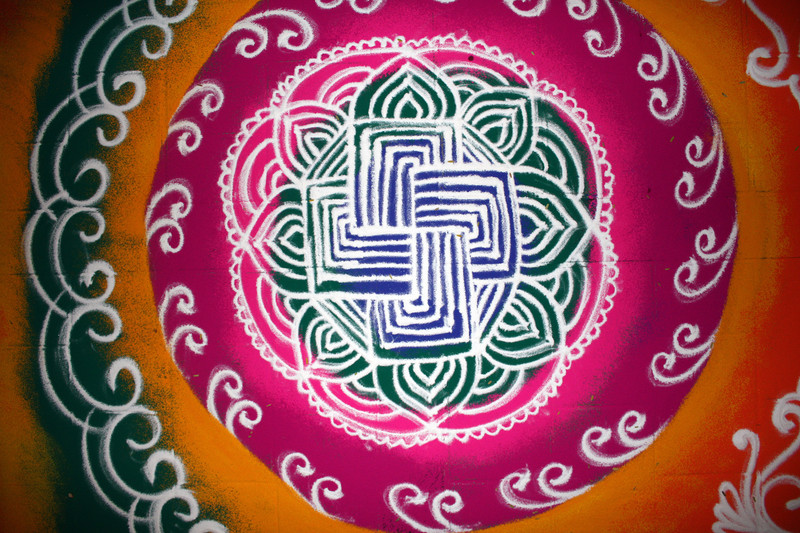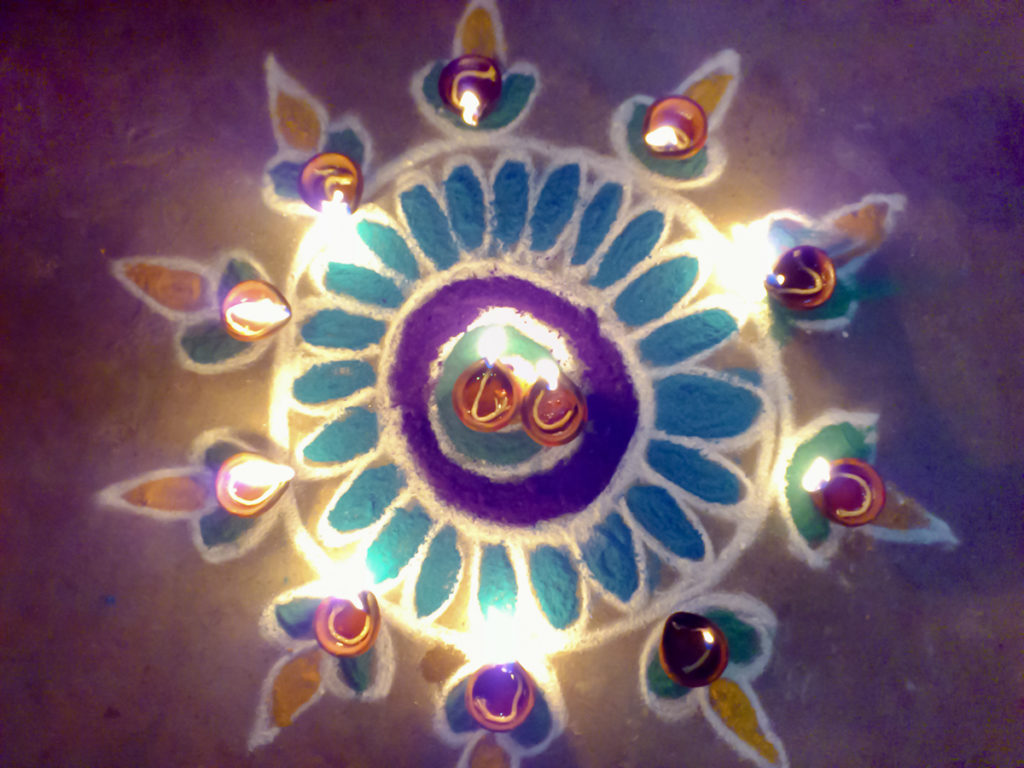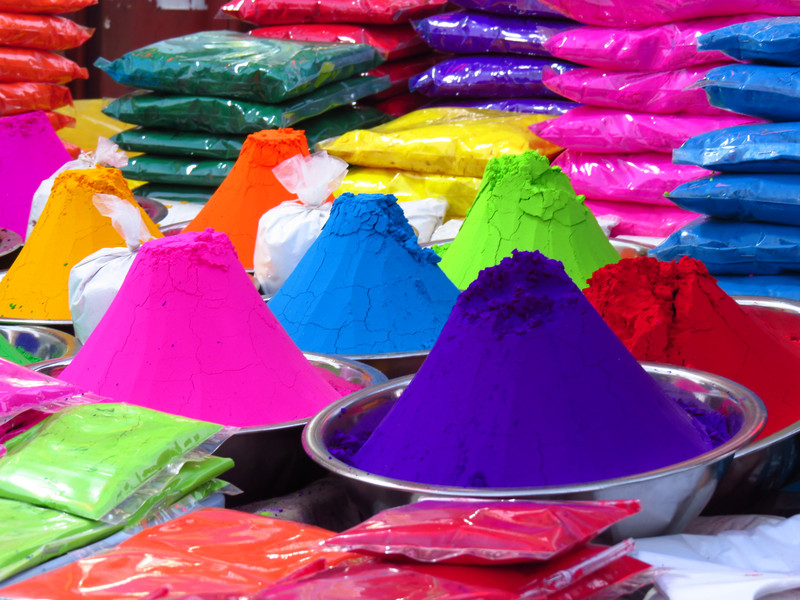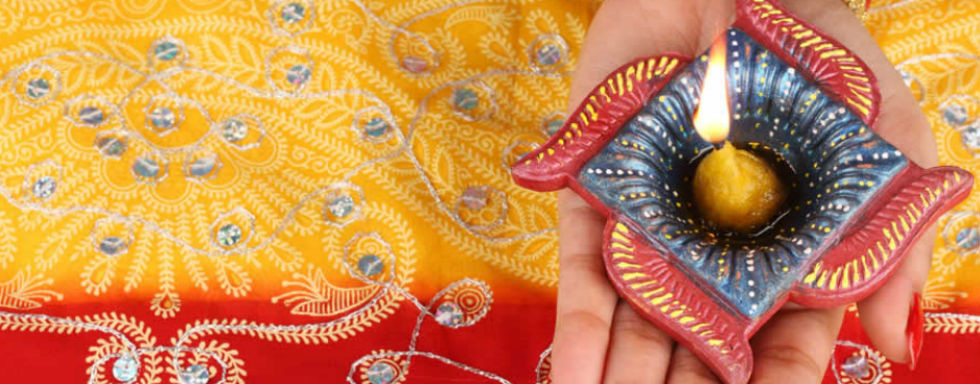
Rangoli, also known as Kolam, is a traditional art form of India, which precedes the ancient arts of sculpture and painting. The term “Rangoli” is derived from the Sanskrit word, “Rangavalli”. In this art, patterns are created on the floor of living rooms and in courtyards using materials like coloured rice or sand, red brick powder or dry flour. Floral Rangolis are created using flowers and their petals. Chemical colours are the latest addition for creating these patterns.
It is believed to have originated from the Indian state of Maharashtra and later spread all over the country. Elaborate rangoli patterns and designs are an integral part of all religious rituals. They are usually drawn during Indian festivals like Onam, Pongal, Diwali and other festivals.
Underlying Philosophy
Generally Rangolis are a symbol of welcome to the Hindu Gods, It is believed that Gods enter places where rangolis are drawn. Though they add to the aesthetics, they are mainly believed to bring in prosperity and luck. Alternatively, it is also believed that a rangoli guards the house and prevents evil spirits from entering in.
Rangolis have been an art form exclusively for women throughout the ages. They are elaborately drawn on special events like festivals, marriages, auspicious functions and other celebrations.
The two main purposes of creating Rangolis are to invoke spirituality or auspiciousness and to create beautiful aesthetics. Even the designs of Rangoli are not merely superficial and have a deep meaning. A curved line brings about a better effect of beauty than a straight geometrical pattern.
History of Rangoli in Tamil Nadu
It is believed in Tamil Nadu that Lady Andal the staunch devotee of Lord Thirumal, married the Lord in the Tamil month of Marghazhi (December 15 – January 15). So during this month, it is a tradition for unmarried girls to rise before dawn break and create rangolis to welcome the Lord into the house. The art form was developed in the South during the reign of Chola kings. The designs are usually based on nature but sometimes they are also in the form of an abstract art.
There are instances in Hindu mythology where this art form is mentioned. In the Ramayana, it is mentioned that the wedding pavilion of Ram and Sita was decorated with Rangoli patterns.
Canvas for Rangoli/Where it is drawn?
It is usually drawn as elaborate and intricate patterns with a plethora of colours at the entrance of a house in the outer courtyard. It is a symbol of welcome to the Goddess Lakshmi, thereby bringing wealth, prosperity and happiness into the home.
Symbolic Representation
It is believed that the negativity that hangs in the air around a house gets entangled in the complex patterns of a rangoli. They ward off evils and prevent them from entering the house. This is the main reason for complicated and intricate designs. Rangolis also serve as an inspiration for positive thinking to help us lead a prosperous life.
Designs

The designs are numerous and vary from simple geometrical patterns, flowers or petals to highly complex deity impressions. There is no restriction on the size of a rangoli and it can vary anywhere from the size of a doormat to cover the entire room. Rangolis can also be drawn together by a large number of people. In ancient India, Rangoli was a family tradition and it was a way to bring for the whole family to spend time together. Whatever be the size of the design, Indian festivals like Diwali and Pongal are incomplete without a Rangoli. Also the patterns vary to reflect the traditions, practices and folklore unique to each area of India.
One important thumb rule of a rangoli design is that the entire pattern should be drawn in one stroke as an unbroken line. This is because it is believed that evil spirits can enter the house through gaps in the pattern.
Rangoli Artists/Who creates Rangolis?
Traditionally women create the Rangoli patterns at home. It is a freeform art and doesn’t require the help of geometrical devices like a ruler, thread, paint brush and so on. Women use only their fingers and rice powder, coloured chalk or crushed lime powder to create enchanting patterns. Rangolis are embellished with flowers, beads, grains or pulses. When done with expertise, Rangolis surpass the beauty of a spectacular painting.
The rangoli powder is a specially made coarse powder that flows freely. A pinch of this powder is taken between the index finger and thumb. The powder is slowly released as the hand moves to create the desired pattern.
Preparation for the Rangoli
The place where the Rangoli is to be created is cleaned thoroughly. It was a traditional practice to sweep and sprinkle cow dung on every doorstep. Once it dried, Rangolis were drawn on it. Today, Rangolis are drawn after the place is swept and sprinkled with water. Once the place is ready, the design is decided. Specific points are placed with the powder on the floor. Then these points are joined together to create the particular design.
Traditional Beliefs Behind Rangolis
Traditionally rangolis were created only using rice flour. The main reason for this is the principle, “Vasudhaiva Kutumbakam”, in “Sanatana Dharma”, which means “the whole world is one big family”. This is based on the value of “Live and Let Live”. The reason why our ancestors used rice flour was to provide food for ants, insects, worms, birds and other living beings that live in the soil.
The designs are passed from one generation to the next. This helped in preserving both the art form and the tradition.
Rangoli is created in different states of India with different names:
Tamil Nadu - Kolam
Karnataka - Rangoli
Kerala - Golam, Kolam, Kalam
Andhra Pradesh - Muggu
Chattisgarh - Chaookpurna
Uttar Pradesh - Chowk Pujan
Bihar - Aripana
West Bengal - Alpana
Rangoli Powder

Traditionally rice flour was used as Rangoli powder. But now it is made by pounding a lustrous and breakable mineral (Shirgola) into a coarse powder. It is also made by burning the husks of rice to obtain a white ash that is used as Rangoli powder. This method is followed in the Konkan region that comprises parts of Maharashtra and Goa.
It is advisable to use eco-friendly colours that don’t harm your skin as well as the tiny guests who feast on your beautiful artwork.
Practice this traditional art form of India and welcome prosperity and good luck into your homes.

